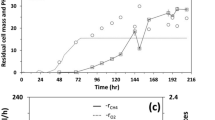Abstract
H2 production from cellulose, using rumen fluid as the inoculum, has been investigated in batch experiments. Methanogenic archaea were inhibited by acid pre-treatment, which also inhibited cellulolytic microorganisms, and in consequence, the conversion of cellulose to H2. Positive results were observed only with the addition of cellulase. H2 yields were 18.5 and 9.6 mmol H2 g cellulose−1 for reactors with 2 and 4 g cellulose l−1 and cellulase, respectively. H2 was primarily generated by the butyric acid pathway and this was followed by formation of acetic acid, ethanol and n-butanol. In reactors using 4 g cellulose l−1 and cellulase, the accumulation of alcohols negatively affected the H2 yield, which changed the fermentation pathways to solventogenesis. PCR–DGGE analysis showed changes in the microbial communities. The phylogenetic affiliations of the bands of DGGE were 99 % similar to Clostridium sp.



Similar content being viewed by others
References
Abreu AA, Alves JI, Pereira MA, Sousa DZ, Alves MM (2011) Strategies to suppress hydrogen-consuming microorganisms affect macro and micro scale structure and microbiology of granular sludge. Biotechnol Bioeng 108:1766–1775
APHA (American Public Health Association), American Water Works Association, Water Environment Federation (1998) Standard methods for the examination of water and wastewater, 20th edn. APHA, Washington
Barros AR, Silva EL (2012) Hydrogen and ethanol production in anaerobic fluidized bed reactors: performance evaluation for three support materials under different operating conditions. Biochem Eng J 61:59–65
Cheong DY, Hansen CL (2006) Bacterial stress enrichment enhances anaerobic hydrogen production in cattle manure sludge. Appl Microbiol Biot 72:635–643
Chong ML, Raha AR, Shirai Y, Hassan MA (2009) Biohydrogen production by Clostridium butyricum EB6 from palm oil mill effluent. Int J Hydrogen Energy 34:764–771
Datar R, Huang J, Maness PC, Mohagheghi A, Czernik S, Chornet E (2007) Hydrogen production from the fermentation of corn stover biomasss pretreated with a steam-explosiom process. Int J Hydrogen Energy 32:932–939
Dubois M, Gilles KA, Hamilton JK, Rebers PA, Smith F (1965) Colorimetric method for determination of sugars and related substances. Anal Chem 28:350–356
Ho CY, Chang JJ, Lin JJ, Chin TY, Mathew GM, Huang CC (2011) Establishment of functional rumen bacterial consortia (FRBC) for simultaneous biohydrogen and bioethanol production from lignocelluloses. Int J Hydrogen Energy 36:12168–12176
Hu ZH, Wang G, Yu HQ (2004) Anaerobic degradation of cellulose by rumen microorganisms at various pH values. Biochem Eng J 21:59–62
Lakshmidevi R, Muthukumar K (2010) Enzymatic saccharification and fermentation of paper and pulp industry effluent for biohydrogen production. Int J Hydrogen Energy 35:3389–3400
Lay JJ, Lee YJ, Noike T (1999) Feasibility of biological hydrogen production from organic fraction of municipal solid waste. Water Res 33:2579–2586
Levin DB, Islam R, Cicek N, Sparling R (2006) Hydrogen production by Clostridium thermocellum 27405 from cellulosic biomass substrates. Int J Hydrogen Energy 31:1496–1503
Liu H, Zhang T, Fang HHP (2003) Thermophilic H2 production from a cellulose-containing wastewater. Biotechnol Lett 25:365–369
Lynd LR, Weimer PJ, Van Zyl WH, Pretorius IS (2002) Microbial cellulose utilization: fundamentals and biotechnology. Microbiol Mol Biol Rev 66:506–577
Maintinguer SI, Fernandes BS, Duarte ICS, Saavedra NK, Adorno MAT, Varesche MBA (2011) Fermentative hydrogen production with xylose by Clostridium and Klebsiella species in anaerobic batch reactors. Int J Hydrogen Energy 36:13508–13517
McCullough ME (1968) Influence of hay or silage and ratio of flaked corn or beet pulp to forage on cellulose disappearance in vitro. J Anim Sci 27:780–784
Morrison M, Miron J (2000) Adhesion to cellulose by Ruminococcus albus: a combination of cellulosomes and Pil-proteins? FEMS Microbiol Lett 185:109–115
Nielsen AT, Liu WT, Filipe C, Grady L Jr, Molins S, Stahl DA (1999) Identification of a novel group of bacteria in sludge from a deteriorated biological phosphorus removal reactor. Appl Environ Microbiol 65:1251–1258
Nissila ME, Tahti HP, Rintala JA, Puhakka JA (2011a) Thermophilic hydrogen production from cellulose with rumen fluid enrichment cultures: effects of different heat treatments. Int J Hydrogen Energy 36:1482–1490
Nissila ME, Tahti HP, Rintala JA, Puhakka JA (2011b) Effects of heat treatment on hydrogen production potential and microbial community of thermophilic compost enrichment cultures. Bioresour Technol 102:4501–4506
O’Sullivan CA, Burrell PC (2007) The effect of media changes on the rate of cellulose solubilisation by rumen and digester derived microbial communities. Waste Manage 27:1808–1814
Ratti RP, Botta LS, Sakamoto IK, Varesche MBA (2013) Microbial diversity of hydrogen-producing bacteria in batch reactors fed with cellulose using leachate as inoculums. Int J Hydrogen Energy 38:9707–9717
Ren NQ, Xu JF, Gao LF, Xin L, Qiu J, Su DX (2010) Fermentative bio-hydrogen production from cellulose by cow dung compost enriched cultures. Int J Hydrogen Energy 31:2742–2746
Schwarz WH (2001) The cellulosome and cellulose degradation by anaerobic bacteria. Appl Microbiol Biotechnol 56:634–649
Ueno Y, Haruta S, Ishii M, Igarashi Y (2001) Microbial community in anaerobic hydrogen-producing microflora enriched from sludge compost. Appl Microbiol Biotechnol 57:555–562
Wang J, Wan W (2009) Factors influencing fermentative hydrogen production: a review. Int J Hydrogen Energy 34:799–811
Wang A, Gao L, Ren NQ, Xu J, Liu C, Lee DJ (2010) Enrichment strategy to select functional consortium from mixed cultures: consortium from rumen liquor for simultaneous cellulose degradation and hydrogen production. Int J Hydrogen Energy 35:13413–13418
Zhu H, Béland M (2006) Evaluation of alternative methods of preparing hydrogen producing seeds from digestedwastewater sludge. Int J Hydrogen Energy 31:1980–1988
Acknowledgments
The authors acknowledge the financial support of the Fundação de Amparo a Pesquisa do Estado de São Paulo (FAPESP–Process No 2009/15984-0 and No 2010/01237-6).
Author information
Authors and Affiliations
Corresponding author
Rights and permissions
About this article
Cite this article
Ratti, R.P., Botta, L.S., Sakamoto, I.K. et al. Production of H2 from cellulose by rumen microorganisms: effects of inocula pre-treatment and enzymatic hydrolysis. Biotechnol Lett 36, 537–546 (2014). https://doi.org/10.1007/s10529-013-1395-z
Received:
Accepted:
Published:
Issue Date:
DOI: https://doi.org/10.1007/s10529-013-1395-z




